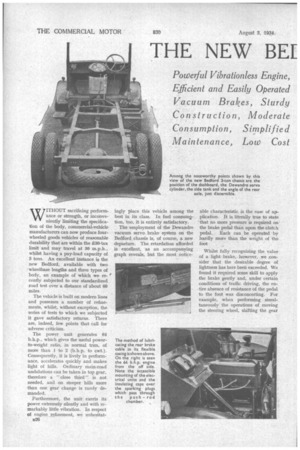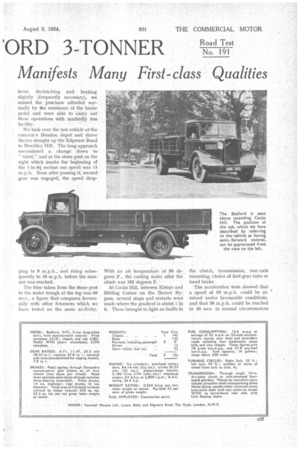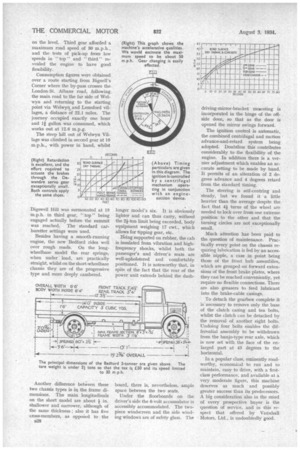THE NEW BEE 'ORD 3-TONNER
Page 38

Page 39

Page 40

If you've noticed an error in this article please click here to report it so we can fix it.
Manifests Many First-class Qualities
WITHOUT sacrificing performance or strength, or inconveniently limiting the specification of the body, commercial-vehicle manufacturers can now produce fourwheeled goods vehicles of reasonable durability that are within the £.30-tax limit and may travel at 30 m.p.h., whilst having a pay-load capacity of 3 tons. An excellent instance is the new Bedford, available with two • wheelbase lengths and three types of body, an example of which we recently subjected to our standardized road test over a distance of about 6 0 miles.
The vehicle is built on modern lines and possesses a number of refinements, whilst, without exception, the series of tests to which we subjected it gave satisfactory returns. There are, indeed, few points that call for adverse criticism.
The power unit generates 64 b.h.p., which gives the useful powerto-weight ratio, in normal trim, of more than 1 to 2 (b.h.p. to cwt.). Consequently, it is lively in performance, accelerates quickly and makes light of hills. Ordinary main-road undulations can be taken in top gear, therefore a "close third" is not. needed, and on steeper hills more than one gear change is rarely demanded.
Furthermore, the unit exerts its power extremely silently and with remarkably little vibration. In respect of engine refinement, we unhesitat B26 ingly place this vehicle among the best in its class. In fuel consumetion, too, it is entirely satisfactory.
The employment of the Dewandre vacuum servo brake system on the Bedford chassis is, of course, a new departure. The retardation afforded is excellent, as an accompanying graph reveals, but the most notice able characteristic is the ease of application. It is literally true to state that no more pressure is required on ' the brake pedal than upon the clutch pedal. Each can be operated by hardly more than the weight of the foot
Whilst fully recognizing the value of a light brake, however, we consider that the desirable degree of lightness has here been exceeded. We found it required some skill to apply the brake gently and, under certain conditions of traffic driving, the entire absence of resistance of the pedal to the foot was disconcerting. For example, when performing simultaneously the operations of moving the steering wheel, shifting the gear lever, declutching and braking slightly (frequently necessary), we missed the purchase afforded normally by the resistance of the brake pedal and were able to carry out these operations with markedly less facility_
We took over the test vehicle at the concern's Hendon depot and drove thence straight up the Edgware Road to Brockley Hill. The long approach necessitated a change down to " third," and at the stone post on the right which marks the beginning of the 1-in-81 section our speed was 15 m.p.h. Soon after passing it, second, gear was engaged, the speed drop
ping to 9 m.p.h., and rising subsequently to 10 m.p.h before the summit was reached.
The time taken from the stone post to the water trough at the top was 69 secs., a figure that compares favourably with other 3-tormers which we have tested on the same acclivity. With an air temperature of 80 degrees F., the cooling water after the climb was 185 degrees F. '
At Cocks Hill, between Elstrpe and Stirling Corner on the Barnet Bypass, several stops and restarts were made where the gradient is about 1 in 6. These brought to light no faults in the clutch, transmission, rear-axle mounting, choice of first-gear ratio or hand brake.
The acceleration tests showed that a speed of 50 m.p.h. could be attained under favourable conditions, and that 30 m.p.h. could be reached in 40 secs. in normal circumstances on the level. Third gear afforded a maximum road speed of 30 m.p.h., and the. tests of pick-up from low speeds in " top " and " third" re vealed the engine to have good flexibility.
Consumption figures were obtained over a route starting from Bignell's Corner where the by-pass crosses the London-St. Albans road, following. the main road to the far side of Wel wyn and returning to the starting point via Welwyn and Lemsford vil
lages, a distance of 22.1 miles. The journey occupied exactly one hour and 14 gallon was consumed, which
works out at 12.6 m.p.g.
The steep hill out of Welwyn Vil lage was climbed in second gear at 10 m.p.h., with power in hand, whilst Digswell Hill was surmounted at 19 m.p.h. in third gear, " top " being engaged actually before the summit was reached. The standard carburetter settings were used.
Besides having a smooth-running engine, the new Bedford rides well over rough roads. On the longwheelbase model the rear springs, when under load, are practically straight, whilst on the short-wheelbase chassis they are of the progressive type and more deeply cambered.
Another difference between these two chassis types is in the frame dimensions. The main longitudinals on the short model are about 4 in. shallower and narrower, although of the same thickness ; also it has five cross-members, as oppos-ed to the
B28
longer model's six. It is obviously lighter and can thus carry, without the 24-ton limit being exceeded, body
equipment weighing 17 cwt., which allows for tipping gear, etc.
Being supported on rubber, the cab.
is insulated from vibration and highfrequency shocks, whilst both the passenger's and driver's seats are well-upholstered and comfortably positioned. It is noteworthy that, in spite of the fact that the rear of the power unit extends behind the dash board, there is, nevertheless, ample space between the two seats.
Under the floorboards on the driver's side the 6-volt accumulator is accessibly accommodated. The twopiece windscreen and the side winding windows are of safety glass. The driving-mirror-bracket mounting is incorporated in the hinge of the offside door, so that as the door is opened the mirror swings forward.
The ignition control is automatic, the combined centrifugal and suction advance-and-retard system being adopted. Doubtless this contributes considerably to the flexibility of the engine. In addition there is a vernier adjustment which enables an accurate setting to be made by hand. It permits of an alteration of 2 degrees advance and 4 degrees retard from the standard timing.
The steering is self-centring and steady, but we found it a little heavier than the average despite the fact that 44 turns of the wheel are needed to lock over from one extreme position to the other and that the turning circles are not exceptionally small.
Much attention has been paid to the question of maintenance. Practically every point on the chassis requiring lubrication is led by an accessible nipple, a case in point being those of the front hub assemblies, which are grouped on forward extensions of the front brake plates, where they can be reached conveniently, yet require no flexible connections. There are also greasers to feed lubricant into the brake-cable casings.
To detach the gearbox complete it is necessary to remove only the base of the clutch casing and ten bolts, whilst the clutch can be detached by the removal of another eight bolts. Undoing four bolts enables the differential assembly to be withdrawn from the banjo-type rear axle, which is now set with the face of the enlarged part at 45 degrees to the horizontal.
In a popular class, eminently roadworthy, economical to run and to maintain, easy to drive, with a -firstclass performance, and available at a very moderate figure, this machine deserves as much and possibly greater success than its predecessors.
A big consideration also in the mind of every prospective buyer is the question of service, and in this respect that offered by Vauxhall Motors, Ltd., is undoubtedly good.






















































































